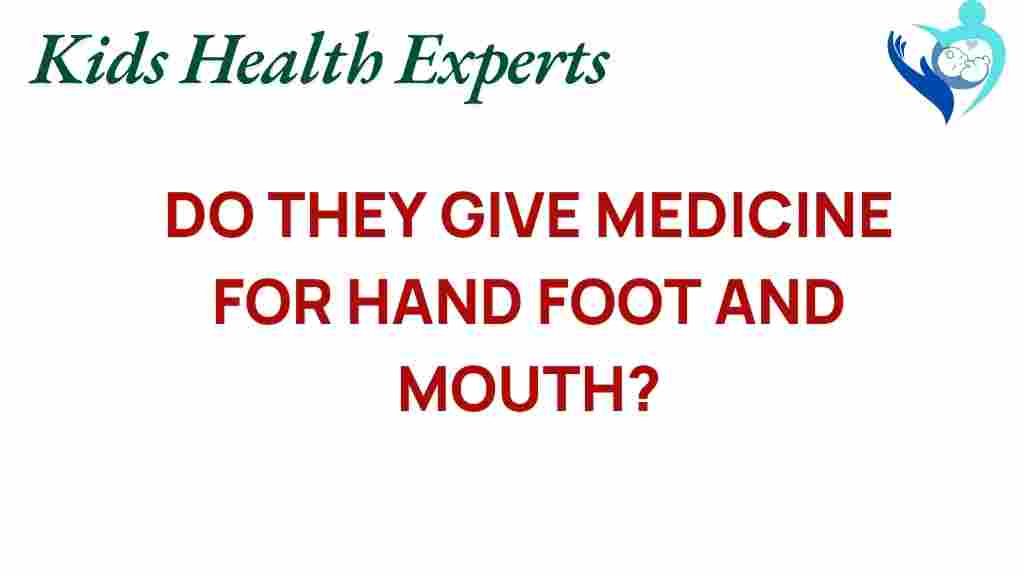Unraveling Treatment Options: Is There Medicine for Hand, Foot, and Mouth?
Hand, Foot, and Mouth Disease (HFMD) is a common viral infection, primarily affecting children under the age of five. It is characterized by fever, mouth sores, and a rash on the hands and feet. As a parent or caregiver, you might be wondering about the treatment options available for this condition, especially when faced with the discomfort your child may experience. In this article, we will explore the symptoms, treatment options, medications, and preventive measures for Hand, Foot, and Mouth Disease.
Understanding Hand, Foot, and Mouth Disease
HFMD is predominantly caused by viruses from the Enterovirus genus, particularly coxsackievirus. The infection is highly contagious and can spread through direct contact with infected individuals or surfaces. Symptoms usually appear within three to six days after exposure and can include:
- Fever
- Sore throat
- Painful sores in the mouth
- Rash on the hands and feet
- Irritability in infants and toddlers
- Loss of appetite
Diagnosis of Hand, Foot, and Mouth Disease
A healthcare professional typically diagnoses HFMD based on the visible symptoms and a physical examination. In some cases, laboratory tests may be performed to confirm the infection, though this is rare. It is essential to consult a pediatrician if you suspect your child has HFMD to rule out other similar conditions, such as chickenpox or herpangina.
Hand, Foot, and Mouth: Treatment Options
There is currently no specific antiviral medication for Hand, Foot, and Mouth Disease. Treatment primarily focuses on alleviating symptoms and providing supportive care. Here are some effective treatment options:
Symptomatic Relief
Since HFMD is a viral infection, the body will typically fight it off on its own. However, symptomatic relief is crucial to make your child comfortable. Here are some methods to consider:
- Pain Relief: Over-the-counter medications such as acetaminophen or ibuprofen can help reduce fever and relieve pain associated with mouth sores. Always consult your pediatrician for the appropriate dosage.
- Hydration: Encourage your child to drink plenty of fluids. Cold liquids, ice pops, and smoothies can be soothing for mouth sores.
- Soft Foods: Offer soft, bland foods that are easy to swallow, such as yogurt, applesauce, and mashed potatoes. Avoid acidic or spicy foods that may irritate mouth sores.
- Oral Rinses: A saltwater rinse or a baking soda solution can help soothe mouth sores. Ensure your child is old enough to rinse and spit safely.
Medications
While there is no specific medication for Hand, Foot, and Mouth Disease, some medications may help alleviate symptoms:
- Topical Pain Relievers: Products containing benzocaine can provide temporary relief for mouth sores. Consult with your healthcare provider before use.
- Antihistamines: These can help reduce itching and discomfort from rashes. Again, seek advice from your healthcare provider for appropriate options.
When to Seek Medical Attention
Monitor your child’s symptoms closely. You should contact a healthcare professional if:
- Your child has a high fever (over 101°F or 38.3°C) that does not respond to medication.
- Your child is unable to drink fluids and shows signs of dehydration.
- The mouth sores prevent your child from eating or drinking.
- Your child exhibits severe symptoms or unusual behavior.
Prevention of Hand, Foot, and Mouth Disease
Preventing HFMD is crucial, especially in communal settings like daycare centers and schools. Here are some effective tips to minimize the risk of infection:
- Hand Hygiene: Teach children the importance of washing their hands frequently with soap and water, especially after using the bathroom and before eating.
- Avoid Close Contact: Keep children with HFMD away from other children until they are no longer contagious. This typically occurs once the fever subsides and the sores begin to heal.
- Disinfect Surfaces: Regularly clean and disinfect frequently touched surfaces and objects, including toys and doorknobs.
- Teach Cough Etiquette: Encourage children to cover their mouths and noses with a tissue or their elbow when coughing or sneezing.
Vaccination and Future Research
Currently, there is no vaccine specifically for Hand, Foot, and Mouth Disease. However, researchers are continually studying the viruses that cause HFMD, and future developments may include vaccination options. Stay informed by following updates from reputable health organizations.
Troubleshooting Tips for Parents
As a parent or caregiver, you may encounter challenges while managing your child’s Hand, Foot, and Mouth Disease. Here are some troubleshooting tips:
- Managing Pain and Discomfort: If over-the-counter pain relievers do not seem effective, consult your healthcare provider for alternative treatments.
- Encouraging Fluid Intake: If your child refuses to drink, try offering fluids in different forms, such as ice chips, flavored electrolyte solutions, or smoothies.
- Addressing Skin Rashes: Keep the affected areas clean and dry. If the rash becomes blistered or shows signs of infection, consult your healthcare provider.
- Monitoring Symptoms: Keep a close watch on your child’s symptoms. If they worsen or do not improve after a few days, seek medical advice.
Conclusion
Hand, Foot, and Mouth Disease is a common viral infection that primarily affects children, causing discomfort and frustration for both the child and the caregiver. While there is no specific medication to treat HFMD, various treatment options exist to alleviate symptoms and ensure your child stays comfortable during recovery. It is crucial to maintain proper hygiene and preventive measures to minimize the risk of infection in communal settings.
Always consult with a healthcare professional if you have concerns about your child’s health or if symptoms persist. For more information on viral infections and their management, visit CDC’s Hand, Foot, and Mouth Disease page. Remember, knowledge is your best tool in ensuring the health and well-being of your child.
By staying informed and proactive, you can help your child navigate through Hand, Foot, and Mouth Disease with greater ease and comfort.
This article is in the category Conditions and created by KidsHealthExperts Team
